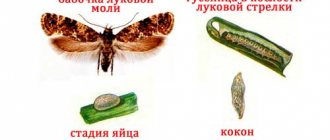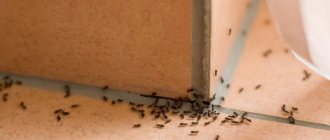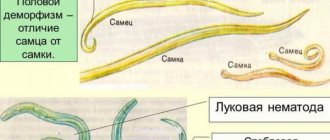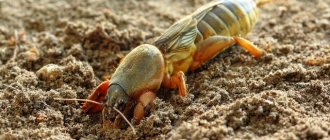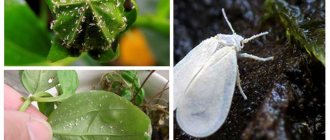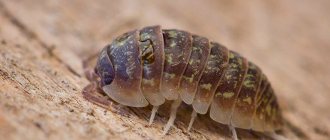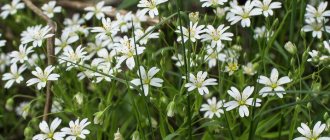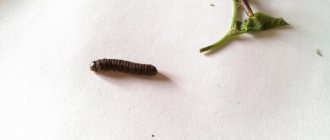Description of the insect
An adult onion moth flying around the beds is unremarkable in appearance. The front wings are colored in dark and light shades of brown and have white markings. The hind wings are beige-gray, framed along the free edge by fairly long hairs.
The insect has 4 stages of development:
- Microscopic oval egg of cream color with a yellow tint with a diameter of 0.4 mm.
- A yellow-green caterpillar that reaches 1 cm in length before metamorphosing, with brown warts on the surface.
- Dark pupa: its length is no more than 0.7 cm; waiting for the time to become a butterfly in a gray cocoon.
- Imago: adult individual.
It is the larvae that harm the plantings. But fighting onion moths involves both repelling and destroying the females before they decide to lay eggs in the garden bed.
Reproduction
The onion moth appears in our area in May, but it is not so easy to see it. This pest prefers to be nocturnal, for which, at least in females, there are reasons. They lay one egg at a time, hiding them on different weeds. In total, the female produces 70 eggs. They have the shape of an ellipse with a length of no more than 0.4 mm.
Within a week, a caterpillar emerges from each egg. It is covered with villi and warts. The newborn very quickly gets to the onion beds and immediately begins its destructive activities.
In the caterpillar stage, the onion moth lives no more than ten days. Then she looks for a secluded place on suitable weeds to create a cocoon, which is a kind of house in which the caterpillar pupates. This is the next stage of development.
The onion moth pupa is quite large, reaching a length of 7 mm. After 12 days, she transforms into a butterfly, which is soon ready to mate. That is, the cycle begins all over again.
The life of a pest
The active years of onion moths begin in May, when the air is already warm enough. This is a nocturnal insect, preferring to hide in secluded corners during the day, and humans rarely encounter it. For this reason, it is difficult to notice the problem in time. Namely, at night the moth lays eggs.
Reproduction
Over the course of her entire life, a female onion moth can lay 70 eggs. The embryo develops in them within a week, and larvae are born. The caterpillar gnaws through the shell of an onion or garlic feather, climbs into it and begins its parasitic activity inside the leaf. After 12–16 days, the time for pupation will come. The transformation from larva to pupa will occur on the onion and garlic itself, or on plants living nearby. After another 10–20 days from this moment, the pupa will become an adult butterfly, ready for further reproduction.
How dangerous is the onion fly?
An adult fly is safe for vegetables - it feeds on plant pollen and does not harm them. The danger of damage to onion plants lies in the fact that the larva deposited by the fly completely destroys the root, which means the entire vegetable dies. The insect completely eats the head, which becomes soft and rotten - subsequently it cannot be eaten or sent for seedlings. Due to the death of the head on the onion, the green shoots begin to turn yellow - the parasite disrupts the movement of sap throughout the plant, the feathers do not receive the proper amount of nutrients and their tips begin to dry out and lose their healthy color.
The result of fly infestation of onion beds can be the complete destruction of the crop. Due to the actions of the parasite, all varieties die - onions, leeks, sets, and batun. In addition, it is necessary to carefully inspect all plantings and destroy already infected or close to them specimens. This is why experienced gardeners prefer to pre-treat the soil with insecticides such as Fly Beetle and Zemlin.
See also Onions: types and varieties with descriptions
Harm
Although the main threat comes precisely from the yellow-green moth caterpillars, if you notice butterflies you also need to be wary: most likely, they are looking for a suitable place to lay eggs. The larvae that emerge from them will begin to feed on the inner pulp of the feathers, without touching the epidermis of the leaf. An external sign of such a lesion are longitudinal light stripes.
When the caterpillars have caused serious damage, their leaves begin to turn yellow and dry out at the tips. This disrupts the proper process of photosynthesis, which makes the plant weakened. If caterpillars are infested in onion sets, they climb into the bulbs and destroy them.
Caterpillars on onions and garlic: what to do?
The caterpillars feed inside the foliage, they bite into the pulp, while the skin remains intact, so-called mines and caterpillar passages appear in this place. These passages are clearly visible on the leaf; they have an irregular shape and differ in color: the damaged parts of the feathers are lighter. In addition to feathers, caterpillars damage the tissues of flower shoots, gnaw pedicels and subsequently the plant may lose seeds. If the caterpillar penetrates the bulb, the plant dies immediately.
The insect is capable of spoiling a significant part of the expected harvest, so the fight against it must be taken seriously. Chemical treatments against onion moths will, of course, preserve the harvest, but who needs it? Let's look for ways to protect without chemicals.
Fighting onion moths
The fight against onion moths is carried out according to the universal rules of war against garden pests. While the number of uninvited guests is not large, folk remedies will help drive them away from the site. They are safe to use because they are natural. If it is impossible to cope in this way, chemical insecticides specially developed for this purpose are used. But the toxic substances remain in the plants for another month, so their use is impossible shortly before harvest and is strictly regulated by the instructions. It is much easier and more profitable to follow the rules of prevention by preventing moths from laying eggs.
Chemicals
The use of chemicals is justified if more than 2 caterpillars live on each plant, or if the larvae have affected 10% or more of the plantings. The best time to spray beds is when young caterpillars are born, which are very vulnerable during this period.
You can use the following remedies against onion flies:
- "Summer resident". Although this product is intended to kill ants, numerous reviews show that it is very effective against onion moths. To prepare a working solution, you will need to dilute the insecticide in water at the rate of 1 ml per 1 liter of water. To ensure that the active ingredients are securely attached to the surface of the feathers, you need to add a tablespoon of liquid soap.
- "Spark". A chemical insecticide available in tablet form. It is simple to prepare a solution for spraying crops: just dilute 1 tablet in a standard 10-liter bucket, having previously dissolved it in a small container. 1 liter of the prepared solution is enough to treat approximately 10 m2. This is a moderately dangerous drug that can be used with other insecticides and fungicides, with the exception of those that have an alkaline reaction.
- "Karate Zeon". Liquid insecticide based on lambda-cyhalothrin. To prepare a solution for processing onions, you will need to dilute 1 ml in 10 liters. Spraying with this drug is carried out during the growing season. You will need to use Karate Zeon twice with an interval of 10–14 days.
- "Metaphos". This insecticide is sold in 5 ml ampoules containing a chemical emulsion with a concentration of 20%. The drug almost instantly penetrates inside the leaf and begins its work, poisoning the onion moth caterpillars. An added bonus is improved bulb quality. Metaphos has a prolonged effect, because the plantings are protected for about 3 more weeks.
All these drugs can only be used in dry and windless weather. The most suitable time of day is morning and evening, when the sun is not high. To get the maximum result from the use of chemicals, it is important to soak the leaves on both sides, preventing the working composition from dripping onto the soil.
It is mandatory to use personal protective equipment and strictly follow the instructions.
Folk remedies
Since the onion fly is a very common pest, vegetable growers have learned to fight it using folk remedies. They do not contain chemicals that can cause poisoning, but their effectiveness is significantly lower than that of industrial insecticidal preparations.
Infusions that fight onion flies:
- ash;
- tobacco;
- hot pepper;
You can prepare these products yourself without fear for your health.
Such infusions contain substances that have a specific taste and aroma that repels pests. Butterflies are unlikely to want to lay eggs on feathers that give off the pungent smell of hot pepper; therefore, spraying should be carried out immediately after the appearance of onion feathers. The procedure is repeated every week. Other tricks:
- Ash and tobacco dust can be effectively used in dry form. To do this, they are mixed in equal parts and distributed over the surface of the bed every 7 days;
- Calendula, yarrow and wormwood repel onion moths. Therefore, it is recommended to plant these plants near the beds with onions and garlic. In addition, they have an attractive appearance and will decorate the site.
- You can build simple traps by cutting off the neck of a plastic bottle (any similar container will do). Liquid bait is poured into it: kvass, syrup, beer, fermented compote and left overnight (required!) on the beds. The moth will be enticed by the attractive scent and drown.
These products are primarily effective against adult onion moths. If their caterpillars have already penetrated the onion, then the use of folk remedies will not bring results.
Prevention
Proper care of onion and garlic plantings also plays an important role. The likelihood of onion moth infection is reduced if:
- observe crop rotation;
- remove weeds in a timely manner;
- regularly loosen the soil in the beds;
- remove all plant debris;
- In the fall, dig or plow the area deeply.
- thin out onions and garlic, without pity removing diseased and weakened plants: the onion fly attacks them first.
- plant carrots and mustard next door: the onion moth does not like them.
By following these rules, the vegetable grower creates unfavorable conditions for the insect.
Onion moth is a common pest whose caterpillars destroy onions and garlic literally from the inside. The use of preventive measures and folk remedies will be useful before infection. If caterpillars do appear, you need to use chemicals as soon as possible.
How to prevent the appearance
How should the fight against onion moths be? First of all, onions, like any other garden plant, need to be properly cared for and taken care of the fertility of the soil underneath them.
Proper crop rotation, regular weeding, watering, fertilizing, loosening the soil are good preventive measures against the appearance of onion moths.
After harvesting, the area must be cleared of remnants of vegetation on the same day, and in the fall, the soil where the onions grew should be deeply dug up.
Do not plant the crop too thickly, and be sure to pick off weak or damaged feathers. They are the first to be attacked by onion moths.
This insect cannot tolerate the smell of carrot tops and mustard. Plant these crops in the area with onions.
Why can worms appear?
There are many reasons why worms appear in garlic, but the most common are:
- Dense landing. The row spacing should be 18-20 cm, and every 6 beds should be separated by sowing nettles or chamomile.
- The collected garlic seeds must be dried and pickled.
- It should be remembered that various types of infusions and decoctions for treatment are effective only in small areas. Large areas should be treated with chemicals.
The reproduction of harmful insects is very fast and has a high turnover. If measures to get rid of pests are not taken in time, the entire crop may die.
Poplar moth
If you look closely at the photo of this pest, you will notice that it is a moth with narrow velvety wings. The main danger of the poplar moth lies in the enormous damage caused not only to poplars, but also to cucumbers, lettuce, apple trees, roses, pears, violets and chrysanthemums. You can fight poplar moths with the help of ichneumon beetles or spring oil used to treat healthy leaves. Diseased shoots must be completely destroyed.
Poplar moth
We hope these tips will help you deal with garden and garden pests. However, remember that folk remedies do not always cope with the task assigned to them. To save the harvest, act for sure - seek help from qualified specialists!
Description of the garlic fly and its characteristic differences
An adult insect is represented by a fly, the length of which does not exceed 8 mm. The color of the body of the garlic fly is rusty-brown. There are short, stiff hairs throughout the fly's body. On the head of the pest it is easy to see the brown eyes of the faceted type. The insect is also equipped with a small proboscis.
The life cycle of a parasite consists of four stages:
- egg;
- larva;
- chrysalis;
- imago.
Sexually mature females lay their eggs between garlic leaves, which are located at the base of the ground, or under the shell of garlic bulbs. Each oviposition can contain about two dozen eggs.
Approximately 8 days after the eggs are laid, larvae appear. Their length reaches 10 mm, they are white and very similar to maggots. They are quite active and do not waste time. The larvae immediately bite into the juicy cloves of garlic. This usually occurs at the base of the leaf.
Active feeding of the larvae continues for almost 3 weeks, then the next stage of the insect’s life cycle begins. The larvae turn into immobile pupae. For this purpose, they burrow into the ground to a shallow depth, where pupation occurs.
The flight of the first generation of garlic flies can be observed in the last days of the first month of summer.
Tobacco thrips
Tobacco thrips
An insect with a narrow body, 0.5-1 mm long, dark brown in color. Thrips have two pairs of wings, they are narrow, fringed with a fringe of hairs. The larva is similar in appearance to an adult thrips, but is smaller in size and does not eat its wings.
Tripe damages onions, cabbage, cucumbers, tobacco, watermelons, tulips, carnations, gladioli, dahlias, lilies, daffodils and other plants. Harmful in open ground and in greenhouses. On onion plants, tripe settles in the axils of leaves and on inflorescences. Adult thrips and their larvae pierce the plant tissue with their proboscis and suck out the juice. At the injection sites, whitish spots appear on the leaves, which merge with each other if the damage is severe. Damaged leaves become distorted and, starting from the top, dry out. The development of the bulbs slows down, they remain small. When the number of thrips is high, onion inflorescences often dry out, and if they form seeds, they are puny and unsuitable for sowing.
Tripe develops in 3-4 generations per year. Adult thrips overwinter in plant debris, in soil and under dry bulb scales. In early spring, thrips feed on weeds, then move on to vegetable and flower crops. Females lay eggs one at a time in leaf tissue. The egg stage lasts 5-6 days. The development of one generation is completed in 15-30 days. In autumn, thrips go to their wintering grounds. Often thrips crawl under the dry scales of the bulbs and end up with them in storage. It is noted (B.A. Gerasimov et al., 1961) that on onion sets, thrips, located between dry and fleshy scales, feed and reproduce all winter.
Measures to combat tobacco thrips
- Proper crop rotation: return onions to the same place no earlier than after 3-4 years.
- Cleaning up plant residues from the garden. Deep digging of the soil in the fall with embedding of plant remains.
- Warming up onion sets infested with thrips at a temperature of +42... +43° C for two days or warming up the sets before planting in hot water at a temperature of +45° C for 10 minutes, at +50° C for 5 minutes.
- After warming up, the sets are cooled in cold water.
Gray neck rot of onions
Gray neck rot of onions
The causative agent of the disease is a fungus. Infection of the bulbs occurs in the beds shortly before harvesting, and the disease manifests itself during storage of the onions.
The spores of the fungus, falling on the lower dying leaves, germinate, and the mycelium penetrates the neck of the bulb. The presence of wounds on the leaves promotes infection. Later, during storage, the tissue in the neck of the bulb decomposes and emits an unpleasant odor. The scales of the bulb are covered with gray mold with small black granular sclerotia. The mycelium spreads throughout the bulb. The affected bulb shrinks. In storage, rot moves from diseased bulbs to healthy ones. High humidity and temperature during storage are favorable for the development of the fungus. The spread of the disease is facilitated by onion mites, which cause wounds to the bulbs. When infected bulbs are planted, diseased, pale yellow plants grow and soon die.
Sources of infection are landing! material and plant remains.
Measures to combat gray neck rot of onions
- Compliance with crop rotation with the return of onions to their original place no earlier than after 3-4 years.
- Careful collection and removal of plant residues from the garden.
- Deep digging of the soil in the fall with embedding of plant remains.
- Selection of healthy bulbs for planting, culling and destruction of diseased ones.
- Sow seeded onions as far as possible from the onion plantings.
- Early sowing and planting of onions. Harvesting onions when the leaves have completely yellowed, drying them in the sun, and in wet weather - under a canopy for 7-10 days.
- When trimming onions, leave a neck at least 3-4 cm long. Place well-dried onions with dried roots for storage. The best storage conditions for onions are air humidity 70-75% and temperature +1... +2' C.
- Periodic sorting of onions during storage, removing diseased bulbs.
Mosaic bow
Mosaic bow
The disease manifests itself during the growing season. The virus infects the leaves and inflorescences of onions.
Yellow-white or cream-colored elongated spots of diseased tissue appear on the leaves. Sometimes the leaves curl or become corrugated and may wilt and droop down.
On the seeds, in addition to the leaves, the inflorescences are affected. They become deformed, the pedicels grow of different lengths, long leaves or bulbs appear on the pedicels instead of flowers, and few or no seeds are produced.
The virus is transmitted from a diseased plant to a healthy one by aphids and mites. The virus is stored in the bulbs. Diseased bulbs have an elongated shape; when stored, they quickly germinate and rot. They are the main source of infection. Onion mosaic virus is not transmitted through seeds or through soil.
Measures to combat mosaic onions
- Getting healthy onion sets. To do this, black onions are sown in areas remote from onion plantings on turnips, from onion seeds and from places where perennial onion species grow.
- Fight against virus carriers - aphids, mites. Removal of diseased plants from onion and turnip plantings during the growing season.
Apple moth
The ermine or apple moth is a white moth with small black dots on its front wings. Despite its name, it poses a danger not only to apple trees, but also to other fruit trees - cherries, plums, sweet cherries and cherry plums. The presence of this pest can be recognized by severe damage to the leaves, resulting in a significant reduction in yield.
Apple moth
The main method of combating apple moth is to treat trees with a decoction of Chernobrivtsev and wormwood:
- Pour 5 liters of water 200 gr. dried flowers.
- Boil the mixture for an hour.
- Pour the same amount of water into 200 grams. dried wormwood.
- Boil for half an hour.
- Let the decoctions cool and filter well.
- Combine both compositions and add 3 liters of water.
- Use for spraying trees when throwing out buds - 2-3 times is enough.
Tomato leaf miner
Tomato leaf miner
The leafminer moth is a small insect with thread-like antennae and a tuft of scales. It can damage both leaves and fruits. To combat this parasite, the following folk remedies are used:
- Introduce predator insects into the area, for example, ichneumon wasps;
- Regularly pour water over the tomato bushes - it will wash away the pests and prevent them from laying eggs;
- Hang yellow boards with adhesive surfaces in the area. Many flying parasites like this color, so they readily land on the board and immediately stick to it;
- Treat tomato bushes with an aqueous solution with the addition of essential oils. To combat tomato moths, essential oils of mustard, lavender, orange, rapeseed, mint and geranium are ideal;
- If possible, plant your tomato area with one of these plants.
Cabbage moth
The cabbage moth, which is a brown or gray moth, parasitizes all members of the cruciferous family. Unfortunately, it is very poorly visible in the garden bed, which cannot be said about the results of the life activity of this insect - the cabbage moth has an excellent appetite and completely gnaws out the leaf blades of plants.
Cabbage moth
Experts identify several ways to get rid of cabbage moths. Let's look at each of them:
- Spray the plants with a decoction of tomato tops. To do this, pour 2 kg of raw material into 5 liters of water and cook for half an hour. Let the mixture brew and cool thoroughly. Filter through cheesecloth, dilute with cold water (the volume should increase 3 times) and add 60 grams of crushed laundry soap;
- Hang birdhouses and feeders on the site for birds, the main enemies of the cabbage moth;
- Spray the cabbage with a solution of wood ash. Dissolve 4 tsp in 10 liters of water. ash. Pour in 1 tbsp. l. liquid brown soap and stir well;
- In the center and along the entire perimeter of the vegetable bed, plant bushes of tobacco, cilantro, mustard, clover or parsley - these plants are a natural barrier to all kinds of pests;
- Water the cabbage with a hot solution made from 1 tsp. pepper (black and red), 2 tbsp. l. mustard and the same amount of salt;
- Use homemade scents that smell like orange, lavender, lemon, tobacco and tangerine - cabbage moths cannot tolerate these odors;
- Make a tincture of dandelion leaves (500 grams of chopped raw materials and 1 tablespoon of liquid soap per 8 liters of water - leave for 3 hours) and use it to treat affected plants. Pay special attention to the back of the leaves.
Signs of defeat
How to determine what exactly the onion fly has affected the crop, because a vegetable can turn yellow due to weather conditions and improper care? A damaged vegetable is quite easy to identify based on several characteristic signs:
- the plant grows slowly and poorly;
- the tips of the shoots begin to dry out and the arrows turn yellow;
- leaves curl into spirals, fall and lose their elasticity;
- an unpleasant smell of rotting appears near the garden bed;
- when digging the head out of the ground, it is revealed to be soft and rotten;
- white worms crawl on the roots;
- Cavities filled with white larvae appear inside the bulb.
If such lesions are detected on a plant, it can no longer be eaten - it must be destroyed. The bulb and green shoots must be burned and carefully removed from the soil so as not to leave larvae in it.
What to do
There are two types of worm control agents; they are divided into folk and chemical means.
Folk remedies
Potassium permangantsovka
This drug effectively fights not only pests, but also fungal diseases. It should be used once every 10-12 days. It is necessary to dilute the solution of warm water with the addition of potassium permanganate until it turns pinkish. This solution should be sprayed on plants and soil. With each treatment, the concentration of the substance should be increased.
One procedure includes two treatments. It is better to carry out treatment the day before watering and the day after.
Makhorka
To prepare the solution, you need 250 g of shag and a spoon of hot pepper per 2 liters of hot water. Place the infusion in a warm place for 3 days. Then strain the infusion and bring the volume to 10 liters. Spray the resulting mixture onto the plants and soil. Treatment should be carried out once a week throughout May and in July against the next generation.
